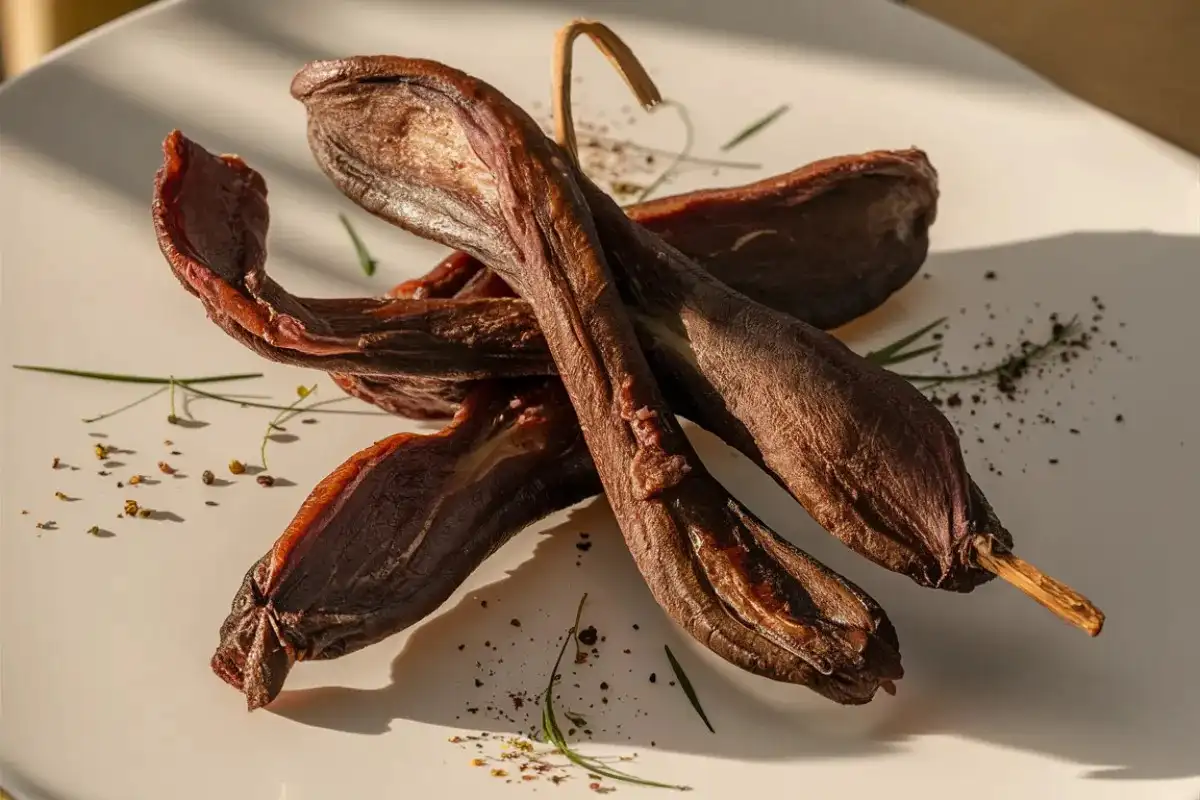Dried meat, a popular and ancient method of preserving food, encompasses a variety of products, such as beef jerky, biltong, dried sausages, and dried fish. People cherish these foods for their long shelf life, rich flavors, and convenient storage. However, many consumers wonder if dried meat goes bad. The short answer is yes, dried meat can indeed go bad. Understanding how you make, store, and manage it can help you extend its freshness significantly.
How is Dried Meat Made?
Dried meat is produced using different preservation techniques like dehydration, curing, or smoking, each designed to remove moisture, which is essential for bacterial growth. Let’s explore these methods in detail:
- Dehydration: The most common method for making dried meat is dehydration. This process involves removing the water content from the meat, either through air-drying, using a dehydrator, or applying low heat in an oven. Without moisture, the bacteria that cause spoilage cannot survive, thereby extending the meat’s shelf life. For example, making beef jerky involves slicing the meat into thin strips, marinating it with seasonings, and drying it in a dehydrator or oven until most of the moisture is removed.
- Curing: Another method involves curing the meat, which means adding salt, sugar, nitrates, or nitrites. These curing agents draw out moisture from the meat through osmosis, which helps to inhibit the growth of bacteria. The addition of nitrates and nitrites not only prevents spoilage but also helps retain the meat’s color and enhance its flavor. Curing is a preferred method for producing items like dried sausages, which are known for their distinct taste and extended shelf life.
- Smoking: Smoking uses low heat and smoke to dry the meat while adding a unique flavor. The smoke contains natural preservatives that help protect the meat from spoilage. The smoking process is commonly used for making dried fish and smoked sausages, which are popular in various cuisines around the world. Smoking can take several hours to days, depending on the desired level of dryness and flavor.
Each of these methods provides a unique taste and texture to the dried meats, which also influences its shelf life. For example, a heavily cured or smoked product may last longer than a simple dehydrated product due to the additional protective barriers against spoilage.
Shelf Life of Different Types of Dried Meat

The shelf life of dried meat varies based on factors such as the type of meat, the method of preparation, and the storage conditions. Below is a detailed look at the shelf life for different types of dried meats:
- Beef Jerky: Typically, beef jerky can last from 1 to 2 years when properly stored in a cool, dark place in airtight packaging. Once opened, the shelf life is reduced, and it should be consumed within a few weeks. For a more detailed guide on this topic, check out our comprehensive article on how long beef jerky lasts.
- Biltong: A South African style of dried meats, biltong is made by air-drying seasoned beef or game meats. Properly stored, biltong can last up to a year if vacuum-sealed and kept away from direct sunlight. Unlike beef jerky, which is often dehydrated using heat, biltong retains a slightly higher moisture content, which can affect its shelf life.
- Dried Sausages: Dried sausages, such as salami or chorizo, are often cured and sometimes smoked. These meats can last for several months to over a year if stored in a cool, dark environment. Because they contain a higher fat content, dried sausages may require refrigeration once opened to prevent rancidity.
- Dried Fish: Dried fish, commonly found in Asian, African, and Scandinavian cuisines, can last several months to a year if properly dehydrated and stored in airtight containers. The smoking and salting process used for dried fish adds an additional layer of protection, but these products should be kept in a cool place to maintain their quality.
Proper Storage Techniques for Dried Meat
To maximize the shelf life of dried meat, proper storage is crucial. Here are some essential tips for storing different types of dried meat:
- Use Airtight Containers: Dried meat should be stored in airtight containers or vacuum-sealed bags to prevent exposure to air and moisture. This practice helps maintain freshness and prevents spoilage caused by humidity or contaminants. Vacuum sealing is particularly effective because it removes air from the packaging, further inhibiting bacterial growth.
- Refrigeration and Freezing: Although dried meat does not always require refrigeration, keeping it in a cool environment can significantly extend its shelf life. Refrigeration is particularly important for products with a higher fat content, like dried sausages, which are prone to rancidity. Freezing is another excellent option, especially for large quantities of dried meats, as it can maintain quality for months or even years.
- Store in a Cool, Dark Place: Temperature fluctuations and exposure to light can accelerate the degradation of dried meats. For long-term storage, keep dried meat in a cool, dark cupboard or pantry. Avoid storing dried meat near heat sources, such as ovens or direct sunlight, which can affect its texture and flavor.
- Avoid Moisture: Moisture is the enemy of dried meat. Ensure that storage areas are dry and that containers are properly sealed. Using desiccant packets or silica gel can help absorb any residual moisture in the packaging, thereby preventing mold growth.
- Check Regularly: Periodically inspect stored dried meats for any signs of spoilage, such as changes in color, texture, or odor. Promptly consume or discard any product that shows signs of deterioration.
Tips for Extending the Shelf Life of Dried Meat

To further extend the shelf life of dried meat, consider the following tips:
- Store in Bulk: Purchase dried meat in bulk and repack it in smaller portions in vacuum-sealed bags. This reduces the amount of time that each portion is exposed to air and potential contaminants.
- Keep in Original Packaging: If the original packaging is vacuum-sealed or airtight, it is often best to keep the dried meats in their original package until you are ready to consume it. Manufacturers design packaging to maximize shelf life, so disturbing it can reduce effectiveness.
- Rotate Stock Regularly: When storing dried meat for extended periods, practice the “first in, first out” method. This ensures that older stock is consumed first, reducing the likelihood of spoilage.
- Use Desiccants and Oxygen Absorbers: Placing food-grade desiccant packets or oxygen absorbers in your storage containers can help remove residual moisture and oxygen, which are primary factors in spoilage.
Signs of Spoilage in Dried Meat
Even when stored correctly, dried meat can eventually spoil. Knowing the signs of spoilage can help you identify when it is no longer safe to consume. Look for the following indicators:
- Visual Changes: Dried meat should retain a consistent color and texture. Any significant changes, such as dark spots, mold, or discoloration, indicate that the meat may have gone bad. Mold is a common spoilage sign, especially if the meat has been exposed to moisture.
- Texture Variations: A change in texture, such as the meat becoming excessively hard, brittle, or slimy, suggests that spoilage may have occurred. Fresh, dried meats should have a firm, chewy texture, not rubbery or sticky.
- Odor Changes: Dried meat should have a pleasant, smoky, or savory aroma. A sour, musty, or rancid smell indicates that the meat has spoiled and should be discarded immediately. The presence of off-odors is often a result of bacterial or fungal growth.
- Unusual Tastes: If the dried meat tastes bitter, metallic, or otherwise off, it is best not to consume it. Spoiled meat can sometimes taste sour or have an unpleasant aftertaste.
The Importance of Rotation and Inventory Management

When storing dried meat, it’s important to keep track of what you have and rotate it regularly. Here are some tips for managing your dried meat inventory:
- Label and Date Packaging: Always label and date the packaging when you store dried meats. This allows you to keep track of when the meat was stored and how long it has been in storage. You can use color-coded stickers or tags to indicate which items need to be used first.
- Organize by Type: Store similar types of dried meat together to help manage your inventory more effectively. For example, keep beef jerky in one area and dried fish in another. This makes it easier to locate what you need and reduces the chance of spoilage due to improper storage conditions.
- Check Regularly: Conduct regular checks of your dried meats inventory to ensure that all items are stored correctly and are within their recommended shelf life. Discard any items that show signs of spoilage.
Using Dried Meat in Recipes
Dried meat can be a versatile ingredient in many dishes. From soups and stews to pasta dishes and salads, dried meats adds a rich, savory flavor. Here are a few ideas on how to incorporate dried meat into your meals:
- Soups and Stews: Dried meat can be rehydrated and used in hearty soups and stews. Its intense flavor adds depth and a satisfying chewiness to the dish.
- Pasta and Rice Dishes: Add small pieces of dried meat to pasta or rice dishes for an extra burst of flavor. The meat’s savory profile pairs well with a variety of sauces and seasonings.
- Salads: Thinly sliced dried meats can be a great addition to salads, offering a protein-rich topping that adds texture and flavor. Pair it with fresh greens, nuts, and a tangy vinaigrette for a balanced meal.
- Snack Platters: Dried meat is an excellent addition to cheese and charcuterie boards. Pair it with different types of cheeses, fruits, and nuts for a delicious and easy-to-prepare appetizer.
By using dried meat creatively, you can enjoy its benefits in a variety of dishes, making it a versatile and valuable pantry staple. If you want to make your own beef jerky at home, this step-by-step beef jerky recipe will help you get started.
Frequently Asked Questions
1. How long does dried meat last?
The shelf life of dried meats depends on its type and storage conditions. Generally, beef jerky can last 1 to 2 years if stored properly, while dried sausages and biltong can last several months to a year.
2. What is the best way to store dried meat?
Store dried meats in airtight containers or vacuum-sealed bags in a cool, dark place. For longer storage, refrigeration or freezing is recommended, especially after opening the package.
3. Can dried meat go bad if it is not refrigerated?
Yes, dried meats can spoil if it is exposed to moisture, air, or improper storage conditions. While it does not always require refrigeration, keeping it cool and dry is essential to prevent spoilage.
4. How can you tell if dried meat has gone bad?
Look for signs like mold, discoloration, changes in texture (hard or slimy), and unpleasant odors. If the meat tastes off or unusual, it is best to discard it.
5. Can you eat dried meat past its expiration date?
It’s not advisable to consume dried meats past their expiration date, especially if there are signs of spoilage. The expiration date indicates the period during which the product is expected to maintain its best quality.
6. Does freezing extend the shelf life of dried meat?
Yes, freezing can significantly extend the shelf life of dried meats, particularly if it has been vacuum-sealed. It helps preserve the meat’s quality and prevents spoilage.
Conclusion
Dried meat offers a convenient and long-lasting food option that can be enjoyed in many ways. By understanding the factors that affect its shelf life and following proper storage techniques, you can extend its freshness and quality for as long as possible. Always keep an eye out for signs of spoilage and use dried meats in diverse recipes to maximize their potential. Remember, whether you are storing beef jerky, biltong, or dried fish, maintaining a cool, dark, and dry environment is key to keeping your dried meats safe and delicious for months or even years to come.

